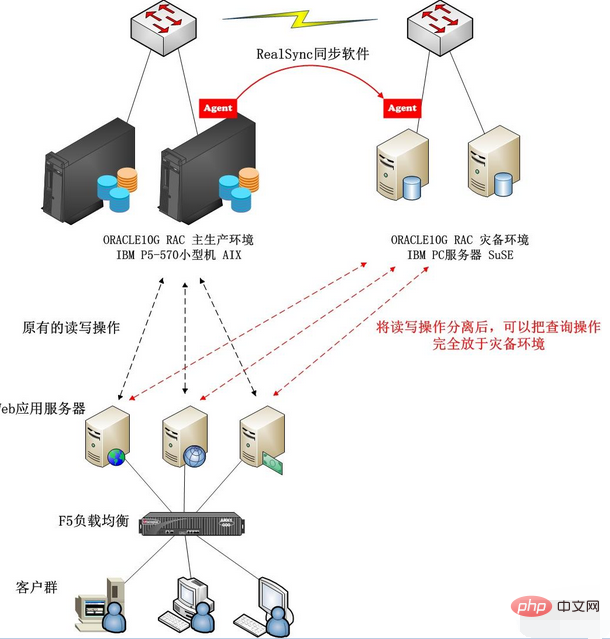How to achieve separation of reading and writing in Oracle
Methods to achieve read-write separation: 1. Use Oracle's own components, including asynchronous transmission supported by physical mode and synchronous transmission supported by logical mode; 2. Use third-party components, including Shareplex, RealSync and DDS , and DSG RealSync synchronization software.

The operating environment of this tutorial: Windows 10 system, Oracle 11g version, Dell G3 computer.
How oracle implements read-write separation
There are many ways to implement Oracle read-write separation:
1 Use Oracle’s own components
DG Solution
The DG solution is also called the ADG solution, and its full English name is Physical Standby (Active DataGuard). Supports recovery and read-only parallelism, but since it is not a logical application mechanism for logs, it is most limited in the scenario of read-write separation. The logfiles of the production machine are transferred to the disaster recovery machine, and the data mirroring capability is guaranteed through Redo Apply technology. Physically Provides consistent mirroring with the production database at the data block level, also called physical mode. Physical mode supports asynchronous transmission, but the disaster recovery machine is in recovery state and is unavailable;
Logical Standby
Restore the received log files through SQL Apply (i.e. Log Miner) technology into a SQL statement and executed on the logical backup database to achieve data consistency, also called the logical method. The logical mode only supports synchronous transmission, but the disaster recovery machine can be in the read-only state
Streams
to copy data to another database in real time for reading. The most flexible, but the least stable.
2 Choose commercial third-party products
The old Shareplex, the local DSG company’s RealSync and Jiuqiao Company’s DDS, or the upstart Oracle GoldenGate, are all is an optional target.
With the acquisition and promotion of GoldenGate by Oracle, I personally believe that GoldenGate will become popular in disaster recovery, data distribution and synchronization.
DSG RealSync synchronization du software implementation plan:

Extended knowledge:
The focus of reading and writing separation In fact, it is data synchronization. There are many technologies that can achieve real-time data synchronization, based on OS layer (such as VERITAS VVR), based on storage replication (most mid-to-high-end storage supports it), based on application distribution or based on database layer technology. Because data synchronization may not be a single DB entire database synchronization, it may involve issues such as business data selection and multi-source integration. Therefore, OS replication and storage replication are not suitable as the first choice technology for read-write separation in most cases.
Log-based Oracle replication technology can be implemented by Oracle's own components, and there are also mature commercial software. Whether to choose commercial independent products or Oracle's own component functions depends on many factors. For example, the team's corresponding technical operation and maintenance capabilities, project investment costs, and the load level of the business system, etc.
Recommended tutorial: "Oracle Video Tutorial"
The above is the detailed content of How to achieve separation of reading and writing in Oracle. For more information, please follow other related articles on the PHP Chinese website!

Hot AI Tools

Undresser.AI Undress
AI-powered app for creating realistic nude photos

AI Clothes Remover
Online AI tool for removing clothes from photos.

Undress AI Tool
Undress images for free

Clothoff.io
AI clothes remover

Video Face Swap
Swap faces in any video effortlessly with our completely free AI face swap tool!

Hot Article

Hot Tools

Notepad++7.3.1
Easy-to-use and free code editor

SublimeText3 Chinese version
Chinese version, very easy to use

Zend Studio 13.0.1
Powerful PHP integrated development environment

Dreamweaver CS6
Visual web development tools

SublimeText3 Mac version
God-level code editing software (SublimeText3)

Hot Topics
 1386
1386
 52
52
 How to check tablespace size of oracle
Apr 11, 2025 pm 08:15 PM
How to check tablespace size of oracle
Apr 11, 2025 pm 08:15 PM
To query the Oracle tablespace size, follow the following steps: Determine the tablespace name by running the query: SELECT tablespace_name FROM dba_tablespaces; Query the tablespace size by running the query: SELECT sum(bytes) AS total_size, sum(bytes_free) AS available_space, sum(bytes) - sum(bytes_free) AS used_space FROM dba_data_files WHERE tablespace_
 How to view instance name of oracle
Apr 11, 2025 pm 08:18 PM
How to view instance name of oracle
Apr 11, 2025 pm 08:18 PM
There are three ways to view instance names in Oracle: use the "sqlplus" and "select instance_name from v$instance;" commands on the command line. Use the "show instance_name;" command in SQL*Plus. Check environment variables (ORACLE_SID on Linux) through the operating system's Task Manager, Oracle Enterprise Manager, or through the operating system.
 How to encrypt oracle view
Apr 11, 2025 pm 08:30 PM
How to encrypt oracle view
Apr 11, 2025 pm 08:30 PM
Oracle View Encryption allows you to encrypt data in the view, thereby enhancing the security of sensitive information. The steps include: 1) creating the master encryption key (MEk); 2) creating an encrypted view, specifying the view and MEk to be encrypted; 3) authorizing users to access the encrypted view. How encrypted views work: When a user querys for an encrypted view, Oracle uses MEk to decrypt data, ensuring that only authorized users can access readable data.
 How to uninstall Oracle installation failed
Apr 11, 2025 pm 08:24 PM
How to uninstall Oracle installation failed
Apr 11, 2025 pm 08:24 PM
Uninstall method for Oracle installation failure: Close Oracle service, delete Oracle program files and registry keys, uninstall Oracle environment variables, and restart the computer. If the uninstall fails, you can uninstall manually using the Oracle Universal Uninstall Tool.
 How to delete all data from oracle
Apr 11, 2025 pm 08:36 PM
How to delete all data from oracle
Apr 11, 2025 pm 08:36 PM
Deleting all data in Oracle requires the following steps: 1. Establish a connection; 2. Disable foreign key constraints; 3. Delete table data; 4. Submit transactions; 5. Enable foreign key constraints (optional). Be sure to back up the database before execution to prevent data loss.
 How to set up users of oracle
Apr 11, 2025 pm 08:21 PM
How to set up users of oracle
Apr 11, 2025 pm 08:21 PM
To create a user in Oracle, follow these steps: Create a new user using the CREATE USER statement. Grant the necessary permissions using the GRANT statement. Optional: Use the RESOURCE statement to set the quota. Configure other options such as default roles and temporary tablespaces.
 How to check invalid numbers of oracle
Apr 11, 2025 pm 08:27 PM
How to check invalid numbers of oracle
Apr 11, 2025 pm 08:27 PM
Oracle Invalid numeric errors may be caused by data type mismatch, numeric overflow, data conversion errors, or data corruption. Troubleshooting steps include checking data types, detecting digital overflows, checking data conversions, checking data corruption, and exploring other possible solutions such as configuring the NLS_NUMERIC_CHARACTERS parameter and enabling data verification logging.
 What to do if the oracle can't be opened
Apr 11, 2025 pm 10:06 PM
What to do if the oracle can't be opened
Apr 11, 2025 pm 10:06 PM
Solutions to Oracle cannot be opened include: 1. Start the database service; 2. Start the listener; 3. Check port conflicts; 4. Set environment variables correctly; 5. Make sure the firewall or antivirus software does not block the connection; 6. Check whether the server is closed; 7. Use RMAN to recover corrupt files; 8. Check whether the TNS service name is correct; 9. Check network connection; 10. Reinstall Oracle software.




